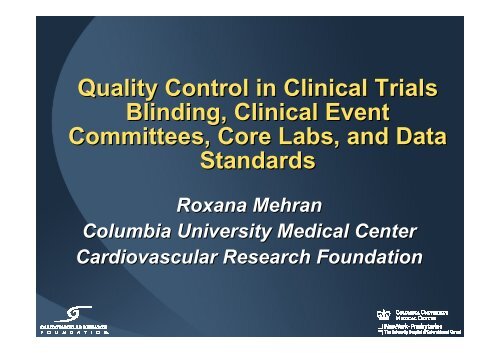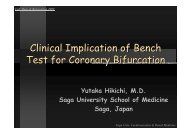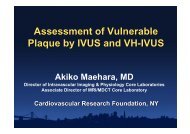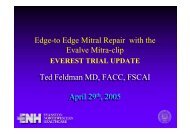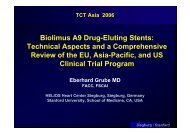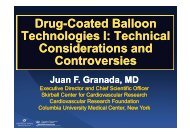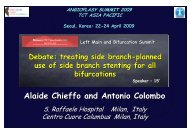Quality Control in Clinical Trials Blinding, Clinical ... - summitMD.com
Quality Control in Clinical Trials Blinding, Clinical ... - summitMD.com
Quality Control in Clinical Trials Blinding, Clinical ... - summitMD.com
You also want an ePaper? Increase the reach of your titles
YUMPU automatically turns print PDFs into web optimized ePapers that Google loves.
<strong>Quality</strong> <strong>Control</strong> <strong>in</strong> Cl<strong>in</strong>ical <strong>Trials</strong><br />
Bl<strong>in</strong>d<strong>in</strong>g, Cl<strong>in</strong>ical Event<br />
Committees, Core Labs, and Data<br />
Standards<br />
Roxana Mehran<br />
Columbia University Medical Center<br />
Cardiovascular Research Foundation
Disclosures<br />
• Research support (significant) from:<br />
The Medic<strong>in</strong>es Company, Boston<br />
Scientific, Cordis, , Medtronic Vascular,<br />
Abbott Vascular, Sanofi/Aventis<br />
• Consultant (Modest): Lilly/Diachi<br />
Sankyo, Medtronic Vascular, Abbott<br />
Vascular, Cordis, Bracco, , The<br />
Medic<strong>in</strong>es Company
Documentation<br />
• Most important tool for assur<strong>in</strong>g quality<br />
control <strong>in</strong> cl<strong>in</strong>ical trials is adequate<br />
documentation of methods used to ma<strong>in</strong>ta<strong>in</strong><br />
quality<br />
• All of the follow<strong>in</strong>g techniques have the<br />
underly<strong>in</strong>g requirement of documentation at<br />
each step.<br />
• Whether it’s approval forms, annotation of<br />
SAS cod<strong>in</strong>g, or <strong>com</strong>pletion of a CRF,<br />
follow<strong>in</strong>g strict documentation guidel<strong>in</strong>es will<br />
assure that anyone look<strong>in</strong>g at the cl<strong>in</strong>ical trial<br />
can understand the quality of the data and the<br />
analysis.
Bl<strong>in</strong>d<strong>in</strong>g<br />
• Prior to study start<br />
• Develop list of personnel<br />
• Their roles<br />
• Access rights to study <strong>in</strong>formation<br />
• When they have access to <strong>in</strong>formation<br />
• Develop rules for unbl<strong>in</strong>d<strong>in</strong>g<br />
• When it should occur<br />
• Who will have access to the unbl<strong>in</strong>ded<br />
<strong>in</strong>formation
• Dur<strong>in</strong>g the study<br />
Bl<strong>in</strong>d<strong>in</strong>g<br />
• Use different site personnel (Investigator and Site<br />
Coord<strong>in</strong>ator) to perform the procedure vs. the follow-up<br />
so the treatment will rema<strong>in</strong> bl<strong>in</strong>ded dur<strong>in</strong>g the follow-up<br />
• Develop a script for follow-up personnel to use <strong>in</strong><br />
obta<strong>in</strong><strong>in</strong>g <strong>in</strong>formation from patients<br />
• Tra<strong>in</strong> follow-up personnel to avoid sections of the<br />
patient’s record that would cause unbl<strong>in</strong>d<strong>in</strong>g<br />
• <strong>Control</strong> <strong>com</strong>munication channels<br />
• Who can send and/or receive <strong>in</strong>formation<br />
• By what methods (phone, email, reports, letters) and<br />
password protection<br />
• What <strong>in</strong>formation can be provided by each method
• Manag<strong>in</strong>g data<br />
Bl<strong>in</strong>d<strong>in</strong>g<br />
• Limit access to data<br />
• Develop list of assigned personnel and their roles<br />
• Limit pr<strong>in</strong>t<strong>in</strong>g of data <strong>in</strong>clud<strong>in</strong>g where to pr<strong>in</strong>t<br />
• Shred pr<strong>in</strong>ted items unless required for<br />
recordkeep<strong>in</strong>g<br />
• do not place <strong>in</strong> trash (too easy for others to pick up and<br />
read)<br />
• Provide isolated area for data review, analysis, data<br />
entry, source document collection for safety<br />
monitor<strong>in</strong>g<br />
• Use <strong>com</strong>puter screen shades when work<strong>in</strong>g <strong>in</strong> open<br />
areas
Bl<strong>in</strong>d<strong>in</strong>g<br />
• Safety monitor<strong>in</strong>g<br />
• Limit access to <strong>in</strong><strong>com</strong><strong>in</strong>g source<br />
documentation<br />
• Redact key identifiers (patient<br />
<strong>in</strong>formation, product usage)
Cl<strong>in</strong>ical Event Committees<br />
• Develop standardized processes for source<br />
document collection<br />
• Request and receipt logs<br />
• Review for <strong>com</strong>pleteness and <strong>com</strong>pile <strong>in</strong>to<br />
written dossier prior to CEC meet<strong>in</strong>g<br />
• Follow-up for ongo<strong>in</strong>g events<br />
• Develop CEC Charter for each trial<br />
• Determ<strong>in</strong>e well-def<strong>in</strong>ed and consistent terms <strong>in</strong><br />
the protocol / <strong>in</strong>vestigational plan so these<br />
def<strong>in</strong>itions can be used for consistency dur<strong>in</strong>g<br />
the adjudication<br />
• Determ<strong>in</strong>e which events are to be adjudicated
Cl<strong>in</strong>ical Event Committees<br />
• Develop standardized CEC processes<br />
• Meet<strong>in</strong>g schedule and required attendees<br />
• Signature form for each meet<strong>in</strong>g<br />
• Adjudication process<br />
• Meet<strong>in</strong>g m<strong>in</strong>utes<br />
• Track<strong>in</strong>g process for event adjudication status<br />
• Develop a reconciliation process<br />
• For events discovered by the CEC dur<strong>in</strong>g adjudication<br />
that meet study endpo<strong>in</strong>ts but were not coded or<br />
reported as such by site staff<br />
• Reconciliation of the cl<strong>in</strong>ical database site reported<br />
events aga<strong>in</strong>st CEC adjudicated events and all database<br />
entries (multiple Core Lab database entries- QCA, IVUS,<br />
ECG, etc.) and CEC adjudicated out<strong>com</strong>es
Cl<strong>in</strong>ical Event Committees<br />
• Include CEC members who are<br />
• Independent from the study<br />
• Knowledgeable <strong>in</strong> the therapeutic area<br />
be<strong>in</strong>g studied<br />
• Experienced <strong>in</strong> the conduct of cl<strong>in</strong>ical<br />
research<br />
• Tra<strong>in</strong> CEC members to<br />
• Study protocol, study def<strong>in</strong>itions, CEC<br />
procedures, case report forms,<br />
adjudication forms
• CRF Design<br />
Core Labs<br />
• Design of CRF (and analysis) tailored to<br />
protocol and knowledge of software<br />
capabilities for valid reproducible analysis<br />
• CRF programm<strong>in</strong>g requires validation and built<br />
<strong>in</strong> cross checks<br />
• Data entry requires 100% QC: double data<br />
entry is optimal, if s<strong>in</strong>gle data entry then<br />
second pass visual validation should be<br />
employed<br />
• Site tra<strong>in</strong><strong>in</strong>g<br />
• Provide detailed, but easy to use <strong>in</strong>structions<br />
to the sites to acquire medium <strong>in</strong> a standard<br />
manner to ensure data quality
Core Labs<br />
• Core Lab analysis<br />
• Tra<strong>in</strong>ed personnel with current tra<strong>in</strong><strong>in</strong>g records,<br />
daily feedback, weekly tra<strong>in</strong><strong>in</strong>g sessions, and annual<br />
tra<strong>in</strong><strong>in</strong>g updates<br />
• Establish a standard process for the Core lab cycle:<br />
receiv<strong>in</strong>g, label<strong>in</strong>g, analyz<strong>in</strong>g, review<strong>in</strong>g, manag<strong>in</strong>g<br />
data, and <strong>com</strong>municat<strong>in</strong>g with data management<br />
group and sponsor<br />
• QC of analysis varies: US standard is 100% review of<br />
technical aspects of analysis<br />
• Validation with measurement accuracy and precision<br />
of quantitative measures and qualitative measures<br />
• Process, validations, analysis must be detailed <strong>in</strong><br />
SOPs that are well ma<strong>in</strong>ta<strong>in</strong>ed and current
Data Standards<br />
• Design effective CRFs<br />
• Design with the f<strong>in</strong>al analysis <strong>in</strong> m<strong>in</strong>d<br />
• Well designed CRFs limit data issues and<br />
<strong>in</strong>crease data entry efficiency and <strong>com</strong>pliance<br />
• Validate Databases<br />
• Ensures proper data collection and report<strong>in</strong>g<br />
• Perform for both the data collection database<br />
and associated edit checks<br />
• Require <strong>in</strong>dependent review (programmers and<br />
other associates who did not develop the<br />
database should perform the validation)
Data Standards<br />
• Develop Data Management Plan<br />
• Provides a clear map for how data will be collected, stored,<br />
cleaned, protected and reported<br />
• Ensures understand<strong>in</strong>g of required functions and study<br />
personnel responsibilities<br />
• Develop Edit Checks, Queries and Reports<br />
• Ensures data quality prior to analysis<br />
• Review how data po<strong>in</strong>ts <strong>in</strong>teract with other data po<strong>in</strong>ts<br />
• Design with the f<strong>in</strong>al analysis <strong>in</strong> m<strong>in</strong>d<br />
• Track queries to ensure resolutions are made <strong>in</strong> a timely<br />
manner<br />
• Develop database report<strong>in</strong>g tools to <strong>com</strong>municate with<br />
<strong>in</strong>vestigative sites, manage enrollment, visit data entry,<br />
outstand<strong>in</strong>g queries and event report<strong>in</strong>gs
Data Standards<br />
• Determ<strong>in</strong>e Access <strong>Control</strong> and Accountability<br />
• Prevents unexpected and unauthorized changes<br />
to the database<br />
• Databases should be equipped with audit trails so<br />
any changes, additions or deletions can be easily<br />
traced<br />
• Develop Data Recovery Strategy<br />
• Develop a plan and test it prior to data collection<br />
• Back-up databases rout<strong>in</strong>ely to ensure easy<br />
recovery if needed due to unexpected failures
History of DSMB<br />
• First used for large randomized<br />
multicenter trials <strong>in</strong> 1960s that were<br />
federally funded <strong>in</strong> the U.S.<br />
• Recognition that <strong>in</strong>terim monitor<strong>in</strong>g of<br />
accumulat<strong>in</strong>g study data was essential<br />
to ensure the ongo<strong>in</strong>g safety of<br />
participants<br />
• Involvement of expert advisors external<br />
to trial would address problems <strong>in</strong> an<br />
unbiased way
Functions of DSMB<br />
• Reviews the accumulat<strong>in</strong>g data from<br />
cl<strong>in</strong>ical trial on an ongo<strong>in</strong>g basis<br />
• Advises sponsor regard<strong>in</strong>g cont<strong>in</strong>u<strong>in</strong>g<br />
safety of trial subjects<br />
• Advises sponsor regard<strong>in</strong>g cont<strong>in</strong>u<strong>in</strong>g<br />
validity and scientific merit of the trial
Determ<strong>in</strong><strong>in</strong>g Need for DSMB<br />
• What is the risk to trial participants?<br />
• An <strong>in</strong>terim analysis of a study endpo<strong>in</strong>t<br />
could be so highly favorable or<br />
unfavorable that study term<strong>in</strong>ation<br />
would be required<br />
• Reasons exist for a safety concern<br />
• Fragile population<br />
• Large, long duration and multicenter<br />
trial
Determ<strong>in</strong><strong>in</strong>g Need for DSMB (2)<br />
• Is DSMB review practical?<br />
• Short duration of trial would limit the<br />
mean<strong>in</strong>gful impact of DSMB<br />
• Limited value for early studies (Phase I<br />
or early Phase 2) where accumulat<strong>in</strong>g<br />
results are known to sponsor and<br />
statistical <strong>in</strong>terpretation of <strong>in</strong>terim data<br />
is less relevant
Determ<strong>in</strong><strong>in</strong>g Need for DSMB (3)<br />
• Will DSMB help assure scientific<br />
validity of the trial?<br />
• Changes over time <strong>in</strong> understand<strong>in</strong>g of<br />
disease, affected population and<br />
standard of care dur<strong>in</strong>g long duration<br />
can lead to modifications to trial – best<br />
if re<strong>com</strong>mended by unbiased group<br />
• Accumulat<strong>in</strong>g event rates may suggest<br />
need for modifications
DSMB Relation to Other Groups<br />
• IRBs / Ethics Committees<br />
• Cl<strong>in</strong>ical Trial Steer<strong>in</strong>g Committee<br />
• Endpo<strong>in</strong>t Adjudication Committee or<br />
Cl<strong>in</strong>ical Events Committee (CEC)<br />
• Site / Cl<strong>in</strong>ical Monitor<strong>in</strong>g<br />
• Investigators<br />
• Sponsor
DSMB Composition<br />
• Cl<strong>in</strong>icians with expertise <strong>in</strong> relevant<br />
cl<strong>in</strong>ical specialty<br />
• Statistician familiar with statistical<br />
methods for cl<strong>in</strong>ical trials and<br />
sequential analysis of data<br />
• Others might <strong>in</strong>clude epidemiologist,<br />
ethicist, pharmacologist<br />
• No conflicts of <strong>in</strong>terest (f<strong>in</strong>ancial,<br />
<strong>in</strong>tellectual, <strong>in</strong>fluence on trial)
DSMB Charter<br />
• Procedural issues<br />
• Meet<strong>in</strong>g schedule, format, structure,<br />
quorum, m<strong>in</strong>utes<br />
• Report formats and codes<br />
• Statistical methods<br />
• Group sequential methods with <strong>in</strong>terim<br />
analyses def<strong>in</strong>ed by time <strong>in</strong>tervals or<br />
amount of <strong>in</strong>formation<br />
• Stopp<strong>in</strong>g rules
DSMB Responsibilities<br />
• Interim monitor<strong>in</strong>g<br />
• Monitor<strong>in</strong>g for effectiveness<br />
• Monitor<strong>in</strong>g for safety<br />
• Monitor<strong>in</strong>g study conduct<br />
• Consideration of external data<br />
• Mak<strong>in</strong>g re<strong>com</strong>mendations<br />
• Ma<strong>in</strong>ta<strong>in</strong><strong>in</strong>g meet<strong>in</strong>g records
Independence of DSMB<br />
• Independence from sponsor<br />
• DSMB rema<strong>in</strong>s objective<br />
• Increases credibility of trial’s<br />
conclusions<br />
• Sponsor ma<strong>in</strong>ta<strong>in</strong>s ability to make trial<br />
modifications <strong>in</strong> response to external<br />
data without <strong>in</strong>troduc<strong>in</strong>g bias
Independence of DSMB (2)<br />
• Sponsor <strong>in</strong>teraction with DSMB<br />
• “Open” part of meet<strong>in</strong>g to review<br />
enrollment, <strong>com</strong>pliance, event rates <strong>in</strong><br />
aggregate as well as sponsor goals,<br />
plans, and resources<br />
• DSMB can address questions from<br />
<strong>in</strong>terim <strong>com</strong>parative data review to<br />
sponsor
Independence of DSMB (3)<br />
• Independence of statistician<br />
• Primary trial statistician has most<br />
knowledge about trial but do<strong>in</strong>g <strong>in</strong>terim<br />
analysis and participat<strong>in</strong>g <strong>in</strong> DSMB<br />
would <strong>com</strong>promise objectivity of DSMB<br />
as well as statistician’s objectivity with<br />
ongo<strong>in</strong>g study management<br />
• Re<strong>com</strong>mendation is to employ a<br />
contractor statistician
Reference:<br />
Guidance for Cl<strong>in</strong>ical Trial Sponsors:<br />
Establishment and Operation of Cl<strong>in</strong>ical<br />
Trial<br />
Data Monitor<strong>in</strong>g Committees<br />
US Food and Drug Adm<strong>in</strong>istration (FDA)<br />
OMB <strong>Control</strong> No. 0910-0581 (March 2006)
Thank You


